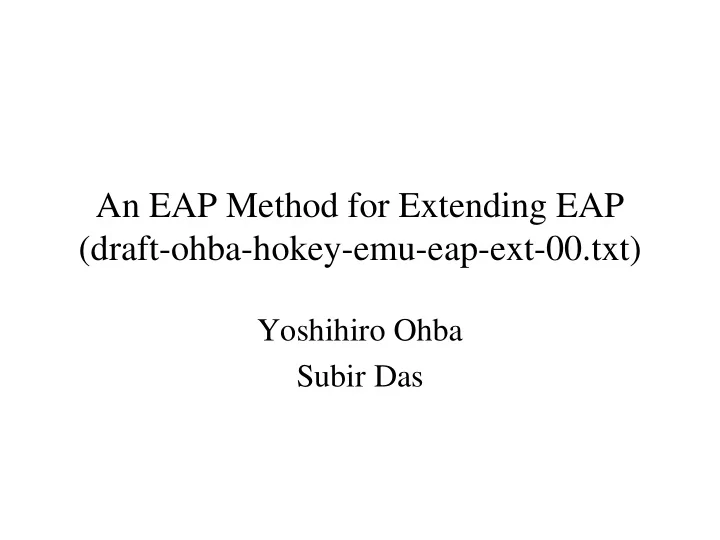

An EAP Method for Extending EAP (draft-ohba-hokey-emu-eap-ext-00.txt) Yoshihiro Ohba Subir Das
Goal: Backwards Compatibility • Allow EAP to add more functionalities including HOKEY, without loss of backwards compatibility with existing EAP and EAP methods implementations
Gap Analysis: EMSK • HOKEY is defining some usage on EMSK – EMSK is mandatory to export in RFC 3748 – In reality, most existing implementations do not export EMSK • WPA and WPA2 certificates do not require EMSK • We can’t blame them because we did not define EMSK usages • Defining EMSK usages with expectation of support from all EAP methods will create a serious deployment gap – Industry may not use HOKEY if there is no smooth migration path • e.g., 802.11i • In addition, a mechanism for enabling and bootstrapping each EMSK usage is needed. However… – Relying on pre-configuration is a bad idea – Defining such a mechanism for every EAP method is also bad – Defining such a mechanism in EAP lower layer could make the situation even more worse
Gap Analysis: Channel Binding • EAP keying identifies two Channel Binding approaches: – Binding based on a KDF – Binding based on parameter exchange • There is no EAP method that “actively” supports Channel Binding – The deployment bar is too high if Channel Binding is required for each EAP method
EAP Facts • EAP is not extensible without providing backwards compatibility for itself – No version field – No extension header – Silent discarding a message with a new Code • Is there any way to add more functionalities to EAP without coming up with EAPv2? – Yes, by defining a new EAP method used for extending EAP – Basic backwards compatibility is provided with NAK
Design choices for a new EAP method to extend EAP • Sequencing in a single EAP conversation – I.e., an authentication method followed by the new EAP method followed by EAP-Success/Failure – Sequencing multiple authentication methods (Types 4 and greater) is not allowed in RFC 3748 except inside a tunneling method • Sequencing EAP conversations – I.e., run an authentication method in an EAP conversation and then start another EAP conversation with the new EAP – Many lower layers do not support sequencing EAP conversations to generate a single network access authorization • Tunneling – I.e., run an authentication method within the new EAP method – Sounds like the most backwards-compatible way
EAP-EXT in a Nutshell • EAP-EXT provides capabilities exchange. – Capabilities: re-authentication and channel binding. Other capabilities such as handover keying can also be added • At least one EAP method (e.g., EAP-TLS) is run inside EAP-EXT for authenticating the peer • After an inner method generates EAP keying material, exchanged capabilities are protected • Even if capability negotiations fail, the peer is still authorized for network access using the basic EAP functionality which is available now • It is allowed to run multiple authentication methods inside EAP-EXT with cryptographic binding – N-th auth method is protected with MSK from (N-1)-th auth method (Integrity chaining) • EAP-EXT exports MSK and EMSK even if inner methods do not generate EMSK – (MSK,EMSK)=KDF(MSK_i, "EAP-EXT-EAP-Keying-Material", 128) • MSK_i : MSK from the last successful inner method
EAP-EXT Example (single auth method) Peer Server | EAP-Request/Identity (optional) | |<---------------------------------------------------| | EAP-Response/Identity (optional) | |--------------------------------------------------->| | EAP-Request/EXT{Cap.(R,C),PRF(1,2),Method(Type X),| Unprotected | CBM(1,2),CBD} | Inner method |<---------------------------------------------------| | EAP-Response/EXT{Cap.(R,C),PRF(1),Method(Type X), | | CBM(1)} | |--------------------------------------------------->| | ... | | EAP-Request/EXT{F,Cap.(R,C),PRF(1,2),Peer-ID, | | Server-ID,Reauth-Key-Lifetime, | | CBM(1,2),CBD,AUTH} | Protected |<---------------------------------------------------| | EAP-Response/EXT{F,Cap.(R,C),PRF(2),CBM(1),AUTH} | (by AUTH TLV) |--------------------------------------------------->| | EAP-Success | |<---------------------------------------------------| Re-auth related parameters Channel Binding parameters PRF negotiation for EMSK
Message Format 0 1 2 3 0 1 2 3 4 5 6 7 8 9 0 1 2 3 4 5 6 7 8 9 0 1 2 3 4 5 6 7 8 9 0 1 +-+-+-+-+-+-+-+-+-+-+-+-+-+-+-+-+-+-+-+-+-+-+-+-+-+-+-+-+-+-+-+-+ | Code | Identifier | Length | +-+-+-+-+-+-+-+-+-+-+-+-+-+-+-+-+-+-+-+-+-+-+-+-+-+-+-+-+-+-+-+-+ | Type | Version |F|E| Reserved | Capabilities | +-+-+-+-+-+-+-+-+-+-+-+-+-+-+-+-+-+-+-+-+-+-+-+-+-+-+-+-+-+-+-+-+ | TLV(s) (optional) ... +-+-+-+-+-+-+-+-+-+-+-+-+-+-+-+-+- 0 1 2 3 4 5 6 7 •F-bit indicates whether this is the final message from the sender +-+-+-+-+-+-+-+-+ •E-bit indicates an error |R C r r r r r r| •Capabilties: R-bit for re-authentication and C bit for Channel Binding +-+-+-+-+-+-+-+-+ •TLV(s): See below 0 1 2 3 0 1 2 3 4 5 6 7 8 9 0 1 2 3 4 5 6 7 8 9 0 1 2 3 4 5 6 7 8 9 0 1 +-+-+-+-+-+-+-+-+-+-+-+-+-+-+-+-+-+-+-+-+-+-+-+-+-+-+-+-+-+-+-+-+ | Type | Length | +-+-+-+-+-+-+-+-+-+-+-+-+-+-+-+-+-+-+-+-+-+-+-+-+-+-+-+-+-+-+-+-+ | Value ... +-+-+-+-+-+-+-+-+-+-+-+-+-+-+-+-+-+-+-
TLVs • PRF TLV: contains a list of PRF algorithms for USRK derivation • Re-auth related TLVs – Peer-ID TLV, Server-ID TLV, Reauth-Key-Lifetime – Actual re-auth mechanism is not specified in this draft • Channel Binding related TLVs – Channel Binding Mechanism TLV: contains a list of CB mechanisms – Channel Binding Data TLV: contains parameters specific to a CB mechanism (some CB mechanism does not require this)
Additional work to be done • Add a TLV for encrypting other TLVs
Summary • Without addressing backwards compatibility issues, industry may not use new functionalities relating to EAP, including HOKEY • This proposal addresses the backwards compatibility issues and allows a smooth migration path to HOKEY
Recommend
More recommend